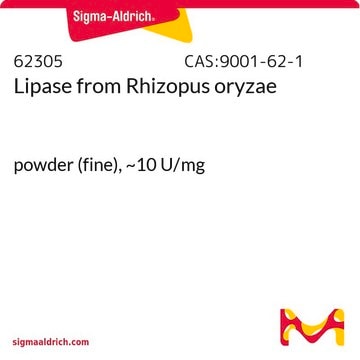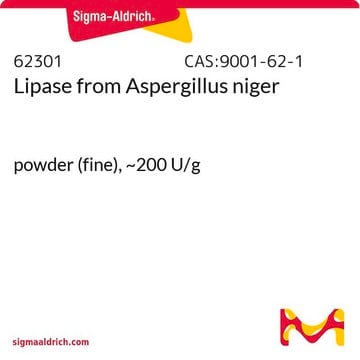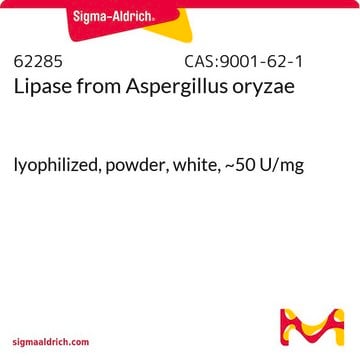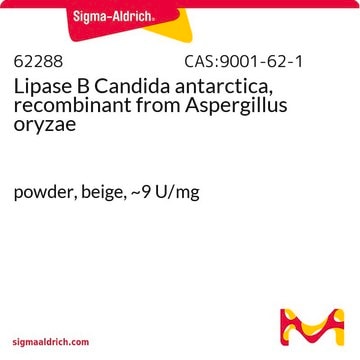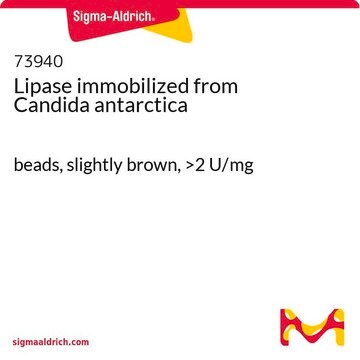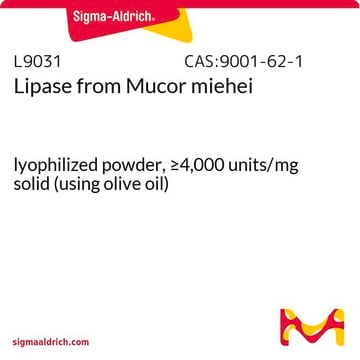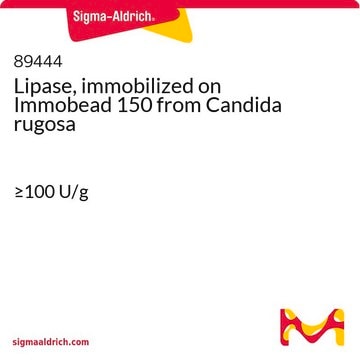80612
Lipase from Rhizopus oryzae
powder, light brown, ≥30 U/mg
Synonyme(s) :
Lipase F-AP 15
About This Item
Produits recommandés
Source biologique
fungus (Rhizopus oryzae)
Forme
powder
Activité spécifique
≥30 U/mg
Couleur
light brown
Température de stockage
2-8°C
InChI
1S/C11H9N3O2.Na/c15-8-4-5-9(10(16)7-8)13-14-11-3-1-2-6-12-11;/h1-7,16H,(H,12,14);/q;+1/b13-9-;
Clé InChI
QWZUIMCIEOCSJF-CHHCPSLASA-N
Description générale
Application
- to replace rabbit gastric extract for infant in vitro digestion
- in the two-phase lipase-catalyzed system for the enzymatic preparation of biodiesel
- in the simulation of infant gastrointestinal digestion in vitro, focusing on the characteristics of emulsions during digestion to replicate the stomach environment and adjust the emulsion pH
Actions biochimiques/physiologiques
These enzymes are widely used to modify the structure of oils and fats, tailoring natural lipids to meet specific properties useful for food, nutrition, and cosmetic applications. Lipases from filamentous fungi families, such as Rhizopus oryzae are extensively utilized in the oil and fats industry due to their high 1,3-regioselectivity toward triglycerides, making them versatile in lipid modification. Lipases are used industrially for the resolution of chiral compounds and the transesterification production of biodiesel.
Définition de l'unité
Remarque sur l'analyse
the optimum temperature is 40°C, the optimum pH is 7.2 (highly active from pH 6.5-7.5)
Mention d'avertissement
Danger
Mentions de danger
Conseils de prudence
Classification des risques
Resp. Sens. 1
Code de la classe de stockage
11 - Combustible Solids
Classe de danger pour l'eau (WGK)
WGK 1
Point d'éclair (°F)
Not applicable
Point d'éclair (°C)
Not applicable
Équipement de protection individuelle
Eyeshields, Gloves, type N95 (US)
Certificats d'analyse (COA)
Recherchez un Certificats d'analyse (COA) en saisissant le numéro de lot du produit. Les numéros de lot figurent sur l'étiquette du produit après les mots "Lot" ou "Batch".
Déjà en possession de ce produit ?
Retrouvez la documentation relative aux produits que vous avez récemment achetés dans la Bibliothèque de documents.
Les clients ont également consulté
Notre équipe de scientifiques dispose d'une expérience dans tous les secteurs de la recherche, notamment en sciences de la vie, science des matériaux, synthèse chimique, chromatographie, analyse et dans de nombreux autres domaines..
Contacter notre Service technique